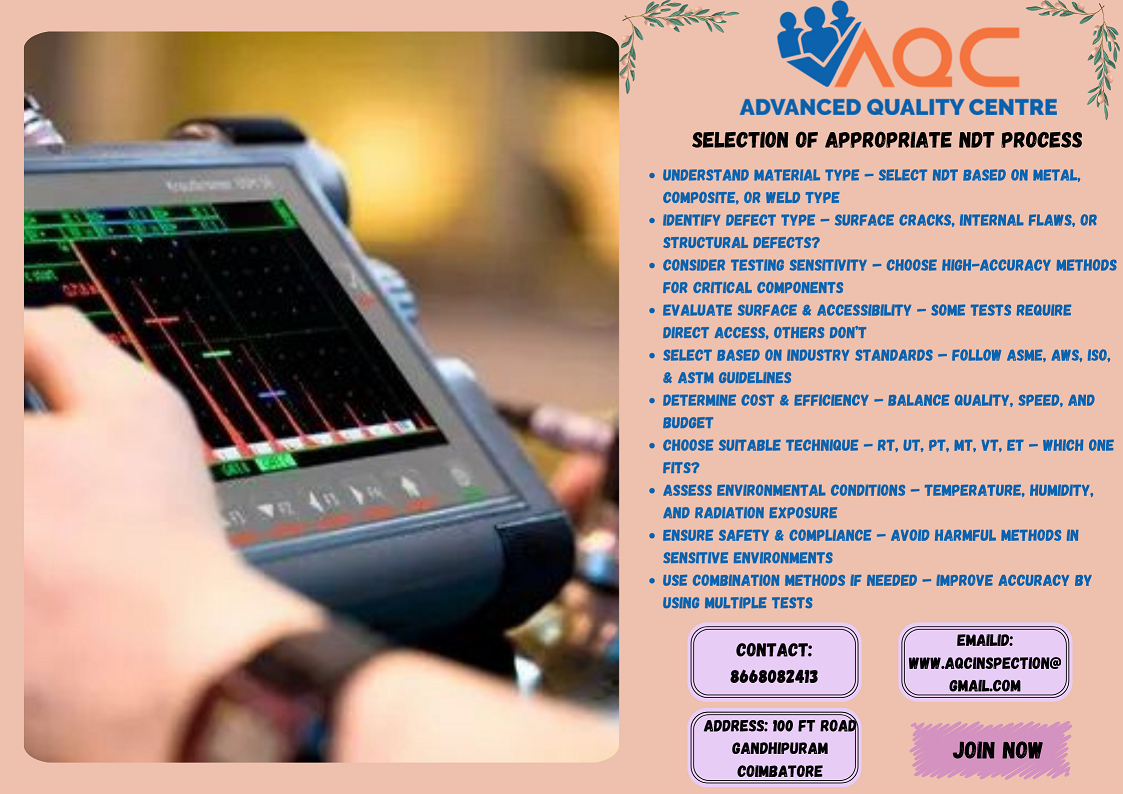SELECTION OF THE APPROPRIATE NDT PROCESS ENSURING QUALITY AND RELIABILITY
Introduction
Non-Destructive Testing (NDT) plays a crucial role in ensuring the quality, safety, and reliability of materials and structures without causing damage. The right NDT process selection is essential for detecting defects, improving product integrity, and maintaining compliance with industry standards. At AQC – Advanced Quality Centre, we provide expert guidance on choosing the most suitable NDT techniques for different applications, helping industries achieve precision testing, cost savings, and superior quality control
Key Factors in Selecting an NDT Method
Choosing the right NDT process selection depends on several factors, including:
- Material Type: Metals, composites, ceramics, and polymers require different testing methods.
- Defect Type & Location: Surface cracks, internal voids, porosity, and weld defects need specific detection techniques.
- Component Size & Geometry: Large, complex structures may need specialized NDT solutions.
- Testing Environment: Field vs. laboratory conditions affect the choice of NDT techniques.
- Regulatory Standards & Industry Compliance: ASME, ASTM, ISO, API, and AWS standards dictate NDT requirements.
- Cost & Time Considerations: Selecting efficient methods that balance accuracy and cost-effectiveness.
Common Types of NDT Methods and Their Applications
Each NDT process has unique advantages and is suited for specific testing requirements.
-
Visual Testing (VT)
- Best For: Surface defects, cracks, misalignment, corrosion, and welding inspections.
- Advantages: Simple, cost-effective, and quick.
- Limitations: Limited to surface-level defects; requires skilled inspection.
-
Ultrasonic Testing (UT)
- Best For: Detecting internal flaws, cracks, laminations, and thickness measurements.
- Advantages: Deep penetration for subsurface defect detection, high accuracy.
- Limitations: Requires skilled operators and clean surfaces for accurate results.
-
Radiographic Testing (RT)
- Best For: Detecting internal voids, porosity, and weld defects in metals and composites.
- Advantages: Provides a permanent inspection record and excellent defect visualization.
- Limitations: Expensive, requires radiation safety precautions.
-
Magnetic Particle Testing (MPT or MT)
- Best For: Detecting surface and near-surface defects in ferromagnetic materials.
- Advantages: Fast and highly sensitive for small cracks.
- Limitations: Limited to ferrous metals; surface preparation required.
-
Dye Penetrant Testing (DPT or PT)
- Best For: Identifying surface cracks, porosity, and leaks in non-porous materials.
- Advantages: Cost-effective, easy to apply, and suitable for non-metallic materials.
- Limitations: Only detects surface defects, requires proper cleaning.
-
Eddy Current Testing (ECT)
- Best For: Detecting surface and near-surface cracks in conductive materials.
- Advantages: Non-contact method, ideal for detecting fatigue cracks.
- Limitations: Limited depth penetration; requires skilled interpretation.
-
Acoustic Emission Testing (AET)
- Best For: Real-time monitoring of crack propagation, pressure vessels, and composite structures.
- Advantages: Detects active defects and structural failures in progress.
- Limitations: Cannot detect static flaws; sensitive to background noise.
-
Leak Testing (LT)
- Best For: Detecting leaks in pipelines, tanks, and vacuum systems.
- Advantages: Highly effective for ensuring airtight and watertight seals.
- Limitations: Some methods require specialized equipment.
-
Infrared Thermography (IRT)
- Best For: Identifying insulation defects, moisture intrusion, and overheating components.
- Advantages: Non-contact method with fast data acquisition.
- Limitations: Interpretation requires expertise; affected by external temperature conditions.
How to Choose the Right NDT Method?
To select the most effective NDT process, consider the following:
- Determine the defect type and inspection requirements.
- Analyze material properties (ferrous, non-ferrous, composite, etc.).
- Consider regulatory and industry standards.
- Evaluate cost-effectiveness and time constraints.
- Assess operator expertise and equipment availability.
Conclusion
Selecting the appropriate NDT method is crucial for ensuring safety, preventing failures, and maintaining product integrity. At AQC – Advanced Quality Centre, we provide comprehensive NDT solutions, expert consultation, and advanced testing services to help industries achieve superior quality control. Contact us today for the best NDT inspection strategies tailored to your needs.
Visit our technical and career updates at our Blog site https://advancedqualitycentre.blogspot.com . or
https://ndtcenter.blogspot.com
Subscribe our youtube channel to know more practical explanations https://aqcinspection.com/

No Comments